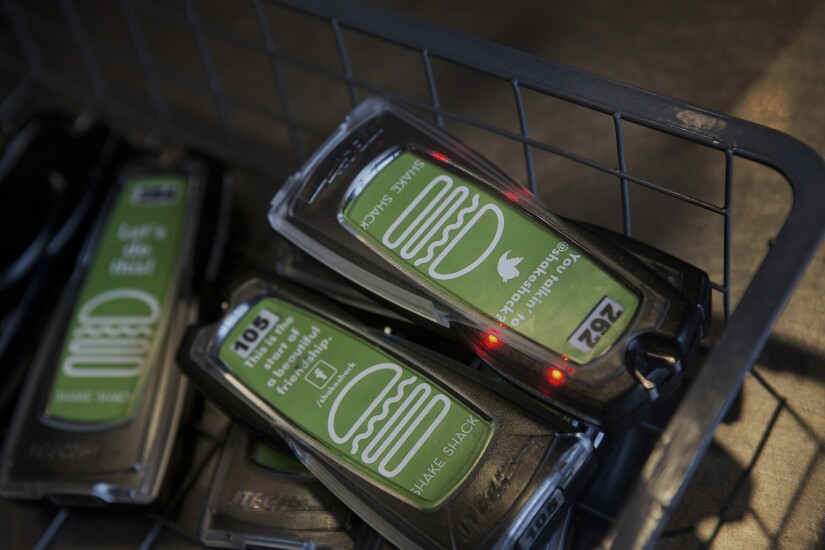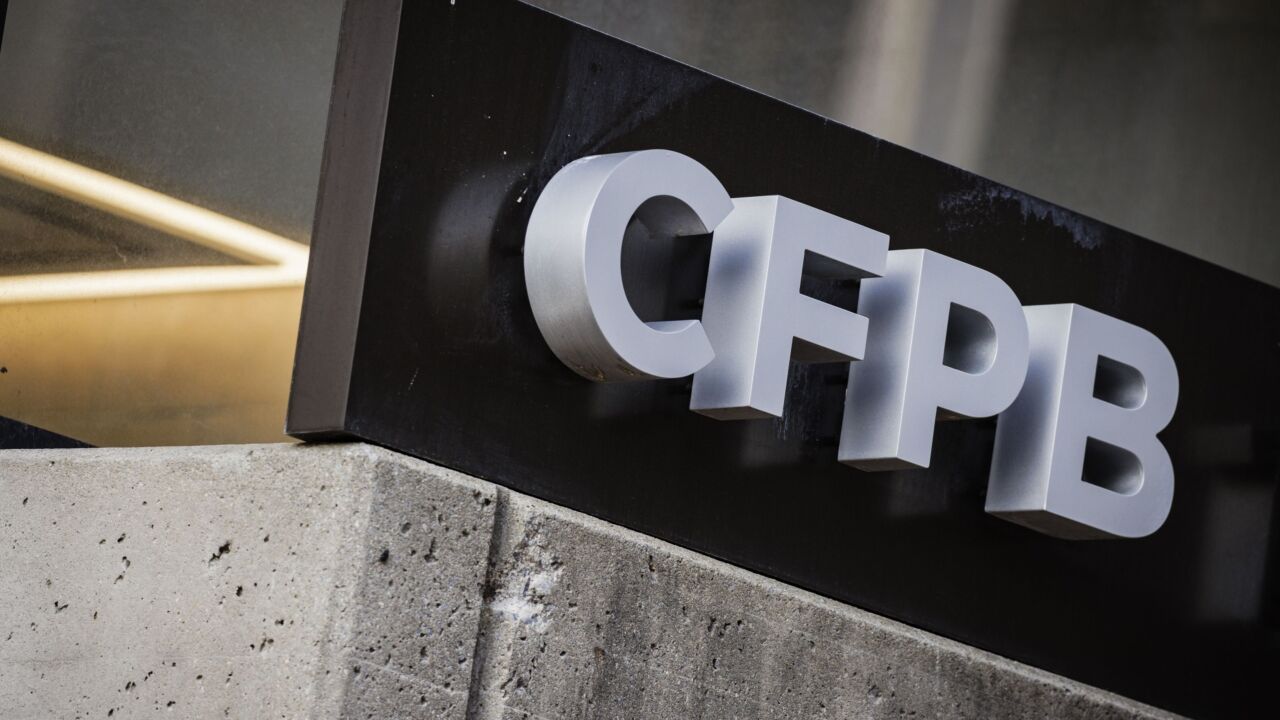

Doing away with cash
Suppressing cash is simply the first step. Through the Astor Place location's use of kiosks and a text messaging system that replaces the pagers it uses at other locations to let patrons know an order is ready, Shake Shack can greatly deepen its relationship with each customer while also slashing its own operational costs.
The typical Shake Shack ordering process involves standing in one of two lines to order (one for food and drink, and a faster line for only drinks), paying a cashier, then waiting again for the pager to buzz when the order is ready. The system results in such long lines that Shake Shack provides a "
Almost all of this process is removed in the company's new model, which relies on kiosks or a mobile device and — crucially — collects the customer's phone number as part of the ordering process so that it can send a text alert when the food is ready.
"Beyond eliminating cash it's about eliminating the point of sale. That's a game changer," said Richard Crone, a payments consultant and researcher.
It's clear that this purely digital system opens new possibilities that might have been just out of reach in a system that still allows cash.
Shake Shack already has an order-ahead app, which should of course be compatible with the new location. The app lets users select a location and pickup time, and remembers customers by either creating a Shake Shack account or asking them to link a Facebook or Google account. In this model, the app handles the payment and also doubles as the buzzer — but one look at the Shack Cam is enough to show that many customers still pay the old fashioned way.

Digital dining
The sandwich chain is piloting its new “Fast Forward” design in a dozen restaurants, revamping in-store design with a new color palette, curated music, comfortable seating with USB charging ports and complimentary Wi-Fi, but the upgrade is more than cosmetic — the chain is experimenting with technology to enable faster customer throughput with self-order kiosks that handle payments as the sandwich is built.
Subway is one of the world’s largest franchises, with over
This isn't Subway's first time trying to overhaul its point of sale technology, but it's a lot more ambitious.
Back in 2014, Subway was a major supporter of the telcos'
Despite its ambition, this partnership didn't change much for Subway patrons.
With Fast Forward, Subway is more focused on what's going on in its stores than what's going on in the broader payments industry.
“We didn’t look at other merchants; we talked to our customers,” said Trevor Haynes, vice president of operations at Subway. “We conducted consumer research in Brazil, Australia, the U.S. and other locations around the world. We asked ourselves, Do customers come in more often when there is a kiosk in restaurant; do they spend more? We told ourselves if the customer doesn’t notice the kiosk, we take it out. What we found was the designs were very well received around the world.”

Food as currency
The chain's WhopperCoin has debuted in Russia, according to
With each purchase of a Whopper, customers receive WhopperCoin tokens through a digital wallet. These reward tokens can eventually be used to purchase Whoppers once the customer has collected enough coins. The tokens can also be transferred and traded online, so customers can sell them to new buyers.
"Now Whopper is not only [a] burger that people in 90 countries love. It's an investment tool as well," said Ivan Shestov, head of external communications at Burger King in Russia, quoted in the Waves release. "According to forecasts, cryptocurrency will increase exponentially in value. Eating Whoppers now is a strategy for financial prosperity tomorrow."

Just add Amazon
“They’re going to try to sell them or give them away at any place they can,” said James Dion, president of Dionco Inc., a retail consulting firm in Chicago. “It’s the old give away the razor and sell the razor blades.”
It's not unheard of for grocery stores to sell electronics and seasonal nonfood items (like sunscreen and garden gnomes), so there may be a logic to treating a grocery store like an electronics store for a limited number of items.
What Amazon is doing differently is being more targeted. Amazon already has a growing business for selling fresh foods, testing models such as AmazonFresh Pickup stores in Seattle and the Amazon Dash Wand for Alexa-assisted bar code scanning in the kitchen. “Amazon is out to own the world,” Dion said.
Since the Whole Foods acquisition, Alexa enthusiasts can now order food and pick it up at a nearby Whole Foods store (Alexa already knows the postal code), or simply have it delivered.

A narrower focus
In trials in London and Woodley, the high-street store is offering online ordering with one-hour and two-hour slots depending on the nature of the order, or in-store pickup, according to
The faster service offers ready-made meals, while the longer delivery window allows shoppers to add groceries. The article notes there are possible hurdles to Marks & Spencer competing with other digital food ordering services, such as its limited offerings compared to rivals such as Tesco.

Hospital food
"What we want is that one trigger or single point of contact for a variety of payments needs," said Kevin Anderson, chief strategy officer at the Santa Monica-based Appetize, which powers point of sale systems for foodservice and "scale events" such as festivals and stadiums.
It's Appetize's first reseller agreement—the company had previously focused on direct sales—and the goal is to quickly place a flexible cloud-based point of sale system inside large care campuses in competition with point of sale providers such as Oracle Micros, NCR and Agilisys.
As commerce moves to online and mobile in addition to traditional point of sale, payments are increasingly being seen as a subset of commerce instead of a standalone function, according to Thad Peterson, a senior analyst at Aite Group.
"As payments become less intrusive, consumer and merchant expectations will evolve to an 'any type, any time, anywhere' model and the distinction between payment types will diminish," Peterson said, adding the the payment industry has lived in a world of well-defined roles, or boxes such as acquirer, processor, payment gateway.
"That model doesn’t really work in a fluid commerce environment," Peterson said. "We’re moving to a mosh pit model for payments."

Take a seat
Los Angeles-based
"The omnichannel capabilities of the new CPK app, in concert with our mobile-optimized digital and social marketing strategy, allow us to reach guests on their preferred technology platform in a relevant and seamless way," said Ashley Ceraolo, CPK's senior vice president of marketing, in a
CPK’s in-app payment system integrates with the CPK Pizza Dough Rewards program that enables diners to earn, track and redeem purchases and rewards, and opt in to receive real-time marketing messages for in-restaurant, online ordering and takeout experiences. Diners pay by linking a payment card within the app, speeding up the checkout process by about 12 minutes, which drives more efficiency during peak hours, Paytronix said.
About 80% of CPK's customers connect with CPK via mobile devices and many already were members of the Pizza Dough Rewards program, which provided an easy ramp to migrate customers to use the app for ordering and checkout in the restaurant, and CPK continues to offer traditional checkout minus a mobile device, Ceraolo said.





